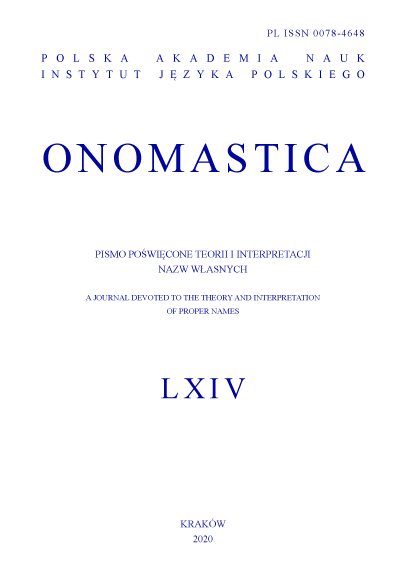Abstract
In the Middle Ages, several name-formation processes played a role in the creation of the anthroponyms in Hungarian. The main name-formation mechanisms were:
1. Semantic name-formation. Within this mechanism, the anthroponym develops through the use of internal elements of the language in such a way that the anthroponymic meaning is created without any change in morphological structure. In Old Hungarian naming practices, the most frequent types of semantic name-formation were:
a. metaphoric name-giving (e.g. farkas ʽfarkas’ [wolf] > anthroponym Farkas),
b. metonymic name-giving (e.g. when an “instrument” of a profession becomes the name of the person practising the given profession; ökör ʽökör’ [ox] > anthroponym Ökör as the name of a butcher),
c. semantic split: e.g. ethnonyms, names of professions, etc., often become anthroponyms without the use of any morphological tool (kovács ʽkovács’ [smith] > anthroponym Kovács).
2. Morphematic construction. In the Old Hungarian period, several suffixes contributed to the creation of anthroponyms, among which the most common ones were: -d(i) ~ -t(i), -s, -a/-e etc. This
morphological solution was the most important tool for adapting foreign names in the Middle Ages: Petrus in Latin > Petr-i, Pet-e, Pet-i, Pet-es in Hungarian.
3. Syntagmatic construction. This process, through the combination of two existing lexemes, cre-
ates an anthroponym composed of two constituents, in which both elements provide a certain
information about the named person.
In this essay I provide an overview of the typical name-formation processes characterising the for-
mation of anthroponyms in Old Hungarian.
References
Benkő, L. (1950). Tővégi magánhangzók rövidült keresztneveinkben. [End-of-vowels in our apocopated given names]. Magyar Nyelv, 46, 230–233.
Benkő, L. (1967). A magyar tulajdonnevek története. [The History of Hungarian Proper Names]. In G. Bárczi, L. Benkő, J. Berrár, A magyar nyelv története [The History of the Hungarian
Language] (pp. 374–388). Budapest: Nemzeti Tankönyvkiadó.
Fehértói, K. (1969). A XIV. századi magyar megkülönböztető nevek [14th century Hungarian distinctive names] (Nyelvtudományi Értekezések 68). Budapest: Akadémiai Kiadó.
Hajdú, M. (2003). Általános és magyar névtan. Személynevek [General and Hungarian onomastics. Personal names]. Budapest: Osiris Kiadó.
Hoffmann, I. (2007). Helynevek nyelvi elemzése (2. kiadás) [The Linguistic analysis of toponyms (Second edition)]. Budapest: Tinta Könyvkiadó.
Hoffmann, I. (2008). A személynévrendszerek leírásához [On the description of personal name systems]. Magyar Nyelvjárások, 46, 5–20.
Kövecses, Z. (2005). A metafora: Gyakorlati bevezetés a kognitív metaforaelméletbe [The metaphor: Practical introduction to cognitive metaphor theory]. Budapest: Typotex Kiadó.
N. Fodor, J. (2010). Személynevek rendszere a kései ómagyar korban. A Felső-Tisza-vidék személyneveinek nyelvi elemzése (1401–1526) [System of personal names in the old Hungarian period. The Linguistic analysis of personal names from the Upper Tisza Region (1401–1526)] (Magyar Névtani Értekezések 2). Budapest: Eötvös Loránd Tudományegyetem Bölcsészettudományi Kar.
OklSz. = Szamota, I., & Zolnai, Gy. (1902–1906). Magyar oklevél-szótár. Pótlék a Magyar Nyelvtörténeti Szótárhoz [Hungarian charter dictionary. Supplement to the Hungarian dictionary of language history]. Budapest: Magyar Tudományos Akadémia.
Pais, D. (1966). Régi személyneveink jelentéstana (2. kiadás) [Semantics of our old personal names (Second edition)]. Budapest: A Magyar Nyelvtudományi Társaság Kiadványai 115.
PRT. = Erdélyi, L., & Sörös, P. (Ed.). (1912–1916). A pannonhalmi Snzent Benedek-rend története [The history of the order St. Benedict in Pannonhalma] (Vols. 1–12). Budapest: Stephaneum.
Reszegi, K. (2009). A kognitív szemlélet lehetőségei a helynévkutatásban. A metonimikus névadás [Possibilities of the cognitive approach in toponymic research. Metonymic name-giving]. Magyar Nyelvjárások, 47, 21–41.
Reszegi, K. (2012). Cognitive Approaches to Hungarian Toponymy. Onoma, 47, 367–379.
Szegfű, M. (1991). A személynévképzés [Anthroponym formation]. In L. Benkő (Ed.), A magyar nyelv történeti nyelvtana. I. A korai ómagyar kor és előzményei. [The historical grammar of the Hungarian language. I. The early Old Hungarian age and its antecedents] (pp. 250–253). Budapest: Akadémiai Kiadó.
Tolcsvai Nagy, G. (2008). A tulajdonnév jelentése [The meaning of the proper name]. In A. Bölcskei, I. N. Császi (Ed.), Név és valóság [Name and reality] (pp. 30–41). Budapest: A Károli Gáspár Református Egyetem Magyar Nyelvtudományi Tanszékének Kiadványai 1.
Tóth, V. (2016). Személynévadás és személynévhasználat az ómagyar korban [Personal name-giving and personal name-usage in the Old Hungarian Era]. Debrecen: Debreceni Egyetemi Kiadó.
Zs . = Zsigmondkori oklevéltár [Diploma Archive of the Sigismund Era] (1951–2009) (Mályusz, E. (Ed.), Vols. 1–7; Borsa, I., & C. Tóth, N. (Eds.), Vols. 8–9; C. Tóth, N. (Eds.), Vol. 10; C. Tóth, N., & Neumann, T. (Eds.), Vol. 11). Budapest: Magyar Országos Levéltár.


